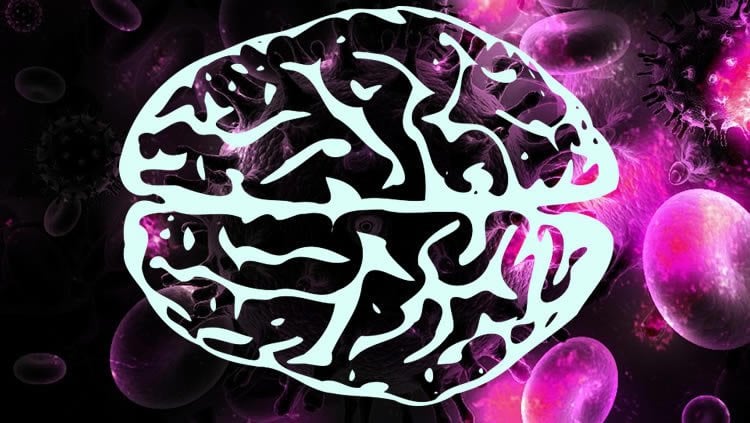Summary: A new math model has helped researchers to uncover the progression of HIV infection in the brain.
Source: University of Alberta.
Research may lead to more effective way of administering drugs to HIV patients.
After uncovering the progression of HIV infection in the brain thanks to a new mathematical model developed by a UAlberta research team, clinicians and researchers are developing a nasal spray to administer drugs more effectively.
The group that developed the model — led by PhD student Weston Roda and Michael Li, a professor in the Department of Mathematical and Statistical Sciences — used data from patients who died five to 15 years after they were infected, as well as known biological processes for the HIV virus to build the model that predicts the growth and progression of HIV in the brain, from the moment of infection onward. It is the first model of an infectious disease in the brain.
HIV infection in the brain has been a proverbial black box for scientists since the development of antiretroviral therapy in the 1990s.
“The nature of the HIV virus allows it to travel across the blood-brain barrier in infected macrophage–or white blood cell–as early as two weeks after infection. Antiretroviral drugs, the therapy of choice for HIV, cannot enter the brain so easily,” said Roda.
This creates what is known as a viral reservoir, a place in the body where the virus can lay dormant and is relatively inaccessible to drugs. Prior to this study, scientists could only study brain infection at autopsy. The new model allows scientists to backtrack, seeing the progression and development of HIV infection in the brain. Using this information, researchers can determine what level of effectiveness is needed for antiretroviral therapy in the brain to decrease active infection.
“The more we understand and can target treatment toward viral reservoirs, the closer we get to developing total suppression strategies for HIV infection,” said Roda. In fact, his results are already being put to use in a University of Alberta lab.

A research team led by Chris Power, Roda’s co-supervisor who is a professor in the Division of Neurology, is planning clinical trials for a nasal spray that would get the drugs into the brain faster–with critical information on dosage and improvement rate provided by Roda’s model.
“Our next steps are to understand other viral reservoirs, like the gut, and develop models similar to this one, as well as understand latently infected cell populations in the brain,” said Roda. “With the antiretroviral therapy, infected cells can go into a latent stage. The idea is to determine the size of the latently infected population so that clinicians can develop treatment strategies”
The paper, “Modeling brain lentiviral infections during antiretroviral therapy in AIDS,” was published in the Journal of Neurovirology.
Source: Katie Willis – University of Alberta
Image Source: NeuroscienceNews.com image is in the public domain.
Original Research: Abstract for “Modeling brain lentiviral infections during antiretroviral therapy in AIDS” by Weston C. Roda, Michael Y. Li, Michael S. Akinwumi, Eugene L. Asahchop, Benjamin B. Gelman, Kenneth W. Witwer, and Christopher Power in Journal of Neurovirology. Published online May 16 2017 doi:10.1007/s13365-017-0530-3
[cbtabs][cbtab title=”MLA”]University of Alberta “Mathematical Modeling Uncovers Mysteries of HIV Infection in the Brain.” NeuroscienceNews. NeuroscienceNews, 19 June 2017.
<https://neurosciencenews.com/math-hiv-infection-6933/>.[/cbtab][cbtab title=”APA”]University of Alberta (2017, June 19). Mathematical Modeling Uncovers Mysteries of HIV Infection in the Brain. NeuroscienceNew. Retrieved June 19, 2017 from https://neurosciencenews.com/math-hiv-infection-6933/[/cbtab][cbtab title=”Chicago”]University of Alberta “Mathematical Modeling Uncovers Mysteries of HIV Infection in the Brain.” https://neurosciencenews.com/math-hiv-infection-6933/ (accessed June 19, 2017).[/cbtab][/cbtabs]
Abstract
Modeling brain lentiviral infections during antiretroviral therapy in AIDS
Understanding HIV-1 replication and latency in different reservoirs is an ongoing challenge in the care of patients with HIV/AIDS. A mathematical model was created to describe and predict the viral dynamics of HIV-1 and SIV infection within the brain during effective combination antiretroviral therapy (cART). The mathematical model was formulated based on the biology of lentiviral infection of brain macrophages and used to describe the dynamics of transmission and progression of lentiviral infection in brain. Based on previous reports quantifying total viral DNA levels in brain from HIV-1 and SIV infections, estimates of integrated proviral DNA burden were made, which were used to calibrate the mathematical model predicting viral accrual in brain macrophages from primary infection. The annual rate at which susceptible brain macrophages become HIV-1 infected was estimated to be 2.90×10−7–4.87×10−6 per year for cART-treated HIV/AIDS patients without comorbid neurological disorders. The transmission rate for SIV infection among untreated macaques was estimated to be 5.30×10−6–1.37×10−5 per year. An improvement in cART effectiveness (1.6–48%) would suppress HIV-1 infection in patients without neurological disorders. Among patients with advanced disease, a substantial improvement in cART effectiveness (70%) would eradicate HIV-1 provirus from the brain within 3–32 (interquartile range 3–9) years in patients without neurological disorders, whereas 4–51 (interquartile range 4–16) years of efficacious cART would be required for HIV/AIDS patients with comorbid neurological disorders. HIV-1 and SIV provirus burdens in the brain increase over time. A moderately efficacious antiretroviral therapy regimen could eradicate HIV-1 infection in the brain that was dependent on brain macrophage lifespan and the presence of neurological comorbidity.
“Modeling brain lentiviral infections during antiretroviral therapy in AIDS” by Weston C. Roda, Michael Y. Li, Michael S. Akinwumi, Eugene L. Asahchop, Benjamin B. Gelman, Kenneth W. Witwer, and Christopher Power in Journal of Neurovirology. Published online May 16 2017 doi:10.1007/s13365-017-0530-3






